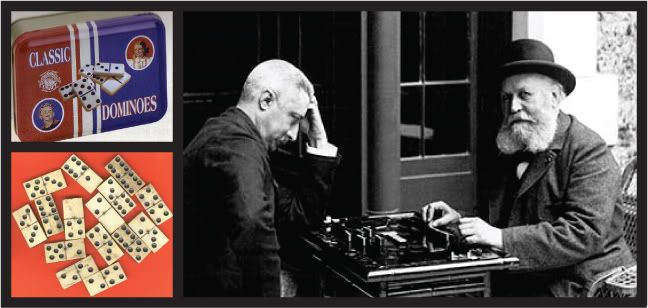
Dominoes have been played for centuries dating all the way back to Asia around 1120 AD when they are believed to have been introduced. Though the exact origin is still speculated by many, the game is believed to be of Chinese decent. In the early 18th century the game found its way to Europe, by way of Italy, and then eventually even further west to America.
The game is played with pieces often referred to as "bones" aptly named as they were originally carved from animal bone or ivory. The bones are rectangular in shape and traditionally have dots or "pips" inset. The pips are arranged in the same manner as six sided dice but since an end of a bone can be blank, there are seven possible faces. Each end of the bone contains an arrangement of pips resembling the 21 possible combinations of throwing two dice. There is also a completely blank tile, which is supposedly for the sake of symmetry.
There are a number of games and versions played all around the globe. Some are far more popular than others, and most vary from region to region. However, there are two main categories that are more commonly played - Block Dominoes and Point Dominoes. Each contains an array of interesting games with sometimes peculiar names including Blind Hughie, Chickenfoot, Muggins, Sniff, and Mexican Train. Nevertheless, the game has been a favorite amongst kings and presidents alike, and is certainly a game that every gentleman should know.
Domino Rules
Shuffling The Dominoes
Before a game or hand begins, the dominoes must be shuffled, so that no one knows the location of any given tile. Usually the stones are shuffled by turning them all face down on the table, then moving them around in a random motion, whilst taking care not to turn over any of the pieces. The collection of shuffled tiles is called the boneyard.
Beginning a Game
Before a game begins, the players have to determine who has the first move. This happens in one of two ways: either each of the players choose a domino at random, with first move going to the player holding the "heavier" domino (these dominoes are returned to the boneyard and reshuffled), or the players draw their allotted number of tiles (which varies according to the game being played), and the holder of the "heaviest" domino goes first.
Drawing Tiles
Once the players begin drawing tiles, they are typically placed on-edge before the players, so that each player can see his own tiles, but none can see the value of other players tiles. Every player can thus see how many tiles remain in the other players hands at all times during gameplay.
Placing the First Tile
Once all the players have drawn their dominoes, the first player (determined either by the drawing of lots, or by who holds the heaviest hand) places the first tile on the table. Typically, this is the double-six. If no one holds the double-six, then the double-five is played, and so on.
Playing Subsequent Tiles
In most domino games, only the "open" ends of a layout are open for play. An end is open when it has no other tile connected to it. Often, a double is placed cross-ways in the layout, straddling the end of the tile that it is connected to. Usually, additional tiles can only be placed against the long side of a double. However, the rules of some games consider all four sides of a double to be open, allowing dominoes to be connected in all four directions.
At any time, due to space constraints or mere whim, a tile may be connected at a right-angle, creating an "L" in the layout.
Drawing Tiles
As the turn passes from player to player, if someone cannot make a move, they're going to do one of two things, based on the game being played. In "block" games (or if there are no tiles left in the boneyard), a player must "pass" if he cannot make a move. In a "draw" game, a player can draw a tile from the boneyard. Depending on the game, he can then either play it (if it fits, and if the rules allow), pass (if he cannot play the drawn tile), or continue drawing until he can make a move or the boneyard is empty.
Currently, most rules allow the boneyard to be emptied completely. However, some rules do not allow the last row tiles in the boneyard to be removed, and at the end of a game, the winner receives the value of the tiles in the boneyard.
Ending a Game
A game ends either when a player plays all his tiles, or when a game is blocked. When a player plays his last time, tradition requires him to say "domino" (when this happens, the other players are said to have been “dominoed”. A game is blocked when no player is able to add another tile to the layout.
When playing a multi-round game, domino games are typically scored by awarding the number of pips on opposing player's tiles to the winner. Doubles may be counted as one or two (if one, a 6-6 counts as 6; if two, a 6-6 counts as 12), and double-blank may either count as 0 or 14. (These rule variations must be agreed upon before the game begins!) The player who reaches the target score (100, 200, or whatever is agreed on among the players), or the player who amasses the most points is a given number of rounds wins the game.

0 comments:
Post a Comment